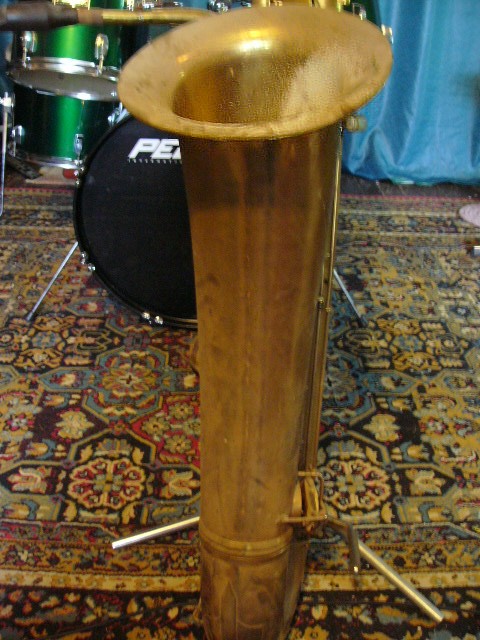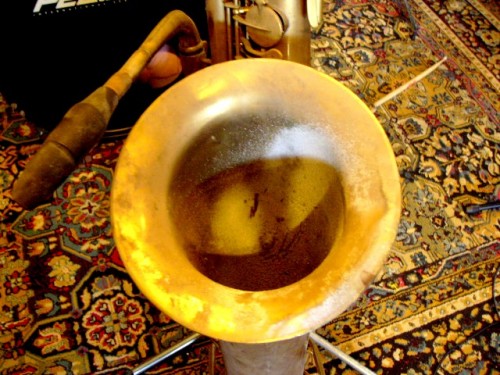There has definitely been a lack of vintage bass saxophones available on eBay lately. And since I have been more or less tracking vintage bass sales on the on-line auction site, the ones that have appeared, have mostly been Bueschers.
This morning I was surprised to see a vintage Conn bass up for auction. What was even more surprising, was its price: < $1,000. 😯
Source: eBay.com
Unfortunately the photos are not very good, and not very plentiful either. It is really difficult to make out any details on this baby, but here is how the seller describes this vintage bass:
YOU ARE BIDDING 0n a a very early and big Bass Saxophone made by C G Conn Elkhart Indiana .It hasn’t been played for who knows how long . It will need a rehab for sure pads etc. . It has some dings and dents some on the bell and the body not as bad as you would think .It looks to be complete really not an expert. . It has engraving looks to be a floral pattern .The only number I see on it is 8405. From the looks maybe early 1900’s . It measure a shade over four feet tall and weight twenty pounds plus . I can truly say I have never owned one of these ! I would think not a whole lot of them around . Also there is no case with this instrument I ONLY ACCEPT PAYPAL . . We ship Fed Ex .
6 ½ % Charged Only For Ohio Residents We will sell not only antiques under the banner of ohmoderne , but the unusual, newer collectibles and what ever else strikes our fancy. So you can expect anything and everything. I have been in the business for forty two years and the last thirty-five strictly as a living .We have also expanded into a music shop called Jackson’s Music, check us out . We buy estates and estate clean – outs. Most of our merchandise is fresh to the market. We try to describe as accurately as we can .Most items I sell are vintage or used, and may have minor flaws. Items are sold as is and sales are final. I attempt to describe each item accurately. Refunds will only be given if I made a major mistake in my description. Please feel free to ask for more detail or photographs before bidding. Please understand that when you bid. Also if you return merchandise or unhappy with a purchase please email at jjackson7@woh.rr.com or through ebay.
Also if you bid and win ,it is a binding contract as any auction is and I expect payment Thanks Jackson’s Antiques & Music
According to the Conn serial number list on drrick.com, this horn’s serial #—8405—would date it to 1903. It is also quite possibly a high pitched horn.
Source: eBay.com
Source: eBay.com
Source: eBay.com
Source: eBay.com
Source: eBay.com
The auction for this vintage (high pitch?) Conn bass saxophone runs until June 11. As I mentioned at the top, at the time of writing the price was <$1,000. There are currently 6 bids on this sax, and the high bid is $610.00.










Update: All I can say is WOW! This sax certainly garnered its share of attention. When all the dust settled, and the auction was over, 17 people bid on this bass sax of unknown–but quite possibly high–pitch. The winning bidder paid $3,651.80 for this vintage Conn.
I hope the new owner gets what he/she wants with this horn. Maybe someday they will check-in here and let us know what it really is.
The problem with a High Pitch horn is that it is not a half step sharp, as that could be worked around. The problem is that it is closer to 50 cents sharp — HALF a semitone. You’d always be “playing in the cracks”, so to speak.
We’ve continued this discussion at http://www.woodwindforum.com/forums/showthread.php?t=3244.
Bottom line: I looked through a few dozen of my Conn Wonder pics and concluded that if it was LOW pitch, it would be stamped “L.” If it was HIGH pitch, it may or may not be stamped. I also followed my comments with pics of a Conn Wonder bass that’s all of a year newer and is quite obviously stamped “L.” I also included a couple known HP Conn Wonders that weren’t stamped with anything.
======================
Allow me to comment, again, on HP vs. LP: if you had a brasswind and you wanted to convert from HP to LP, all you have to do is ad a few bits of tubing. This is easy if you’ve got a trombone and somewhat easy if you’ve got a keyed brasswind. If you’ve got a saxophone, there’s no way of doing it.
Someone’s gonna say, “Well, what if I just make the neck a bit longer or put some paper in the bell? That’s making the horn longer, like in your brasswind example!” Yes, it’s making it longer, but it’s not changing the proportion between the toneholes. That’s why it’ll fail.
Every couple months, I get an e-mail from someone who has, quite specifically, a 19th century Evette-Schaeffer baritone that he insists is an F instrument. Nope. It’s HP, but it’s just a tad sharp. Generally, if I investigate further, the player has to go through a contortion act to get it to play as an F instrument and/or he’s had to do some tonehole, neck or bell modifications.
Bottom line: HP woodwinds cannot be made into LP woodwinds.
Sometimes clarinets can be converted from HP to LP by reducing the bore size. As far as I know, this simply is not an option for saxophones, oboes, or anything else conical. It MIGHT be possible for flutes, but I wouldn’t buy a HP flute unless I KNEW it could be done.
I am the owner of above mentioned Sax. It came into the shop, I am no expert so I listed it with what I could see. I have added to description basic/ sells where is as is if any doubt what it is do not bid. There are no returns because it is an L or an H .
So you make the call
Kind Regards
Jim Jackson
Jackson’s Music
Hello Jim. Welcome to my site.
That addition to the description was wise of you to do. Your bass may be a low pitch sax, and be very usable with today’s other instruments. However, since you can’t be sure one way or the other without further investigation, what it really is, you’re best to cover your bases, and inform potential buyers.
It is a very interesting saxophone. A very unique piece of history. I wish you luck with your sale.
Regards,
Helen
“Possibly high pitch”? Based on the height measurement?
Based on its age, and the notation in Dr. Rick’s serial # chart. If one was interested, one would have to do some serious digging to find out what the possibility was that it was a high pitched horn.
Here’s a quote from Bear at Cybersax that illustrates my point:
And here’s an interesting piece of history from The Conn Loyalist site:
Since this horn was made in 1903, the possibility of it being a high pitch at least exists. A potential buyer should at least be aware, and consider that possibility before bidding.
But what’s the big deal? All you have to do is transpose a half-step…..and you might get a good deal just because it is high pitch. Just as long as the buyer is aware. (how do you move the symbols? I was going to choose the angry man)
Hello Jon. Welcome to my site.
Well I have to disagree with you on that one. Playing a high pitch instrument in a low pitch band is not as simple as just transposing a half-step. It might work, and I stress might, in certain limited applications, but as a general rule, if you have a high pitched horn, you will not fit in very well with the rest of the low pitched orchestra or band. Point in fact, I am currently corresponding with a fellow who has a very vintage–older than this Conn–bari made by Boosey.
This Boosey bari is older than the Conn bass in question by probably at least 10 or perhaps even 20 years. The bari is a high pitched horn, and the the owner has tried to get it to play in tune with modern instruments, but has just not had any luck. This is the norm. Furthermore, most bands, orchestras, etc (unless specifically of the high pitched variety) won’t allow a HP horn in. Just as an aside, I had a fellow from the US contact me a few years ago who was looking specifically for a HP horn of some stripe (can’t remember which now) because he was assembling a HP sax ensemble.
Some players of HP horns have resorted to all kinds of extreme measures, including trying to convert HP horns to LP ones. In the words of saxophone historian Pete Hales: “That’s just not feasible. If you modify the neck and some tone holes AND use some alternate fingerings, it almost works. If you’re a really good player. And you’re into frustration.”
You’re definitely right about the buyer needing to be aware of what they’re buying. That’s why when I decided to mention this on my blog, I put the cautionary note about the possibility of it being a HP sax in my post. When I saw the ad on eBay, there was no mention of that possibility.
Thanks for the visit Jon. Hope to see you here again.
Regards,
Helen
Oh, I meant to ask, I’m not sure what you meant about moving the symbols. If you’re referring to the smilies in the bottom, you just click on them where you want them to go in your comment. For example, if I wanted an angry guy at the end of my sentence, I’d place him here. 😡
The cartoony monster icons at the front of the names are randomly chosen, and no one has any control over them. There are something like 10,000,000 possibilities I believe. No 2 people on my website will have the same one, since it is highly unlikely that more than 10 million different people will ever leave comments on my blog.
Does that answer your question Jon? Or did I misunderstand? I have a really bad headache at the moment, so it’s quite possible that I just didn’t follow you. If I misunderstood, please take another crack at explaining it to me. Thanx…
Hi Helen: Perfect explanation! Thanx! (although I DO walk around confused a lot) I enjoy your website….it is VERY COOL……
Glad that cleared it up Jon… 🙂